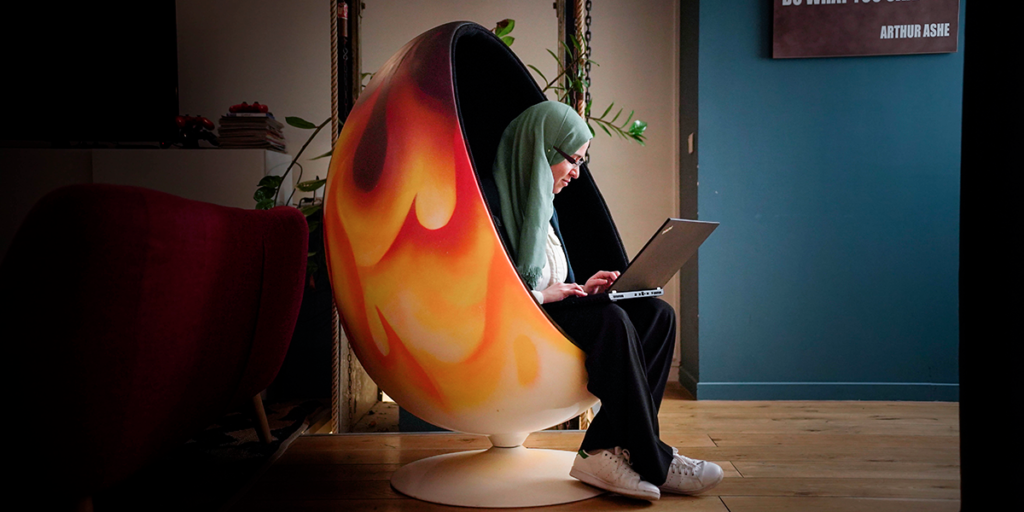ExpertiseNews
What is the status of women in STEM*?
7 minutes

In 2020, we placed the company’s culture at the center of our concerns. As our teams are very diverse and harmonious, we all wanted to preserve these characteristics in the long term. This is why we partnered with OurOffice, an American company offering diversity and inclusion management solutions to companies.
Two years later, OurOffice organized a webinar on “Women and Allies” focusing on the evolution of women in academic and professional careers. I was invited to speak about the curricular, job seeking and early-career part of a woman in technology. This allowed me to take stock of my career path and my feelings over the years.
Parity in STEM starts at school.
In the digital and the commitment to gender equality era, the tech ecosystem is gradually evolving to offer opportunities to youth, and in an inclusive way! From full courses including internships to the occasional hackathons, bootcamps and game jams, students offer themselves – instead of being offered, as they are often the initiators – a wide range of opportunities to learn and grow their technical and entrepreneurial skills. As a student, these activities literally built a staircase for me to gain technical knowledge: starting with the ESI Science Club activities, I had the opportunity to join the Microsoft Student Partner programme, thanks to which I was selected to participate in the NYUAD Hackathon for Social Good in the Arab World, followed by The Port Hackathon at CERN!
However, does it also hold true for younger students? Although the movement is already underway through dedicated platforms, and younger pupils have access to the necessary resources on the internet, a broader and more organized framework is required to familiarize and encourage them to take an interest in STEM.
Frequent and large-scale events, introductions and even competitions starting from middle school onwards would be a good starting point, as they would have the effect of arousing curiosity and passion at a suitable age. In fact, middle school is the place to start demystifying STEM for girls in particular.
I was lucky enough that my father fulfilled this role in my life, when school or extra-curricular environment was far from it. As a child, he taught me how to spot stars and constellations, making me dream so much that I aimed for a career in astrophysics for years! He gave me my first PC and selected the content I could access: few games, lots of cultural, literary and scientific softwares. When I got to post-baccalaureate orientation, I didn’t hesitate to choose computer science, although once I started higher education, I realized that it would’ve been wonderful to find more opportunities earlier.
If we succeed in creating this ideal environment for our youth, secondary school students could reverse the current trend and move towards the scientific specializations and consider technological fields for their post-bac orientation. This is a key issue for France with the growing need for engineers. Engineering universities and schools are booming, yet French companies often have difficulty seeking and hiring these highly-needed profiles. Let’s insist on the fact that encouraging everyone – both female and male – is important. If we are aiming for parity in companies, the work starts with parity on the benches of schools and universities. The solution to the problem at the top of the pyramid would be naturally solved by balancing the base, and there would be no need to impose quotas and other forced measures. At the Higher School of Computer Engineering of Algiers, where I studied computer engineering, we had almost equal numbers of male and female students, something I could not witness in the various French institutions where I studied later on.
Companies’ HR objectives start before recruitment.
Building on such good momentum, it would be equally relevant to strengthen support for students. Practices such as mentoring / coaching, sponsoring and various forms of student involvement in company activities would probably be best. If companies hope to find high-potential, gender-balanced young graduates in the future, they need to be involved in the societal effort of their training! Joining Lucky cart as a work-study student provided me with learning that no school would have equaled. Thanks to it, I very quickly became an interesting candidate in the eyes of recruiters.
Nonetheless, the official entry point for young people into the company will always be the recruitment process. At this decisive stage, ethical and equal recruitment is needed. Expecting commensurate skills and experience with the position needs and salary, and in second position take strong account of parity in the selection criteria for candidates, should become a hiring standard.
Finally, plan for the post-recruitment period: every new employee needs a structured induction to get to better know his or her colleagues and work processes. In the other way around as well, on-boarding should allow all employees to get to know the personality and role of a new member and should also ensure a good knowledge transfer. I was quite surprised when, as soon as I moved from the work-study contract to a permanent contract, my manager asked me to take charge of innovation management in the Data team as a cross-functional task. Being a data engineer, I was expecting a permanent contract where I would not be able to get my nose out of the mega databases. This new mission was a self-discovery, so rewarding and diversified that it still goes on, three years later!
Aiming for parity in a business where women are essential.
Lucky cart’s data team is also a machine which analyses shoppers’ receipts in the FMCG sector to extract knowledge about shopping habits. Guess what, three quarters of the shoppers appearing on these checkout flows are … women! Of course, our data boys are just as well armed with their mathematical and IT knowledge, but we are also happy to count on the intuition of our data girls to conduct the study! Lina, is our main Data Scientist working on our personalized promotion calculation model. She is the queen of programming, very competent in mathematics and algorithms, but sometimes, when presenting the results of her research, she explains to us that “the intuition I have about this feature is …”. Any Data Scientist could relate to this, and in the case of our business, we see a real need for it! As for the Tech team, the future will show us the touch of Tetiana and Pauline, freshly recruited and the first Tech girls in the history of Lucky Cart. What is already certain is that thanks to them, the team speaks more English on a daily basis. What better way to internationalize Lucky cart!
A look back at the Women and Allies webinar on women in STEM
It was with all these points in mind that I prepared my presentation at the webinar. I had the pleasure of doing so alongside a superb panel who discussed these issues from the perspective of French professionals, compared to the state of play in the US. We talked about the key factors for France to improve the situation of women in the workplace, the challenges that still need to be addressed and how we see the situation in 5 years, and more broadly in the future.



